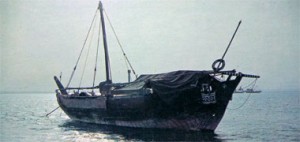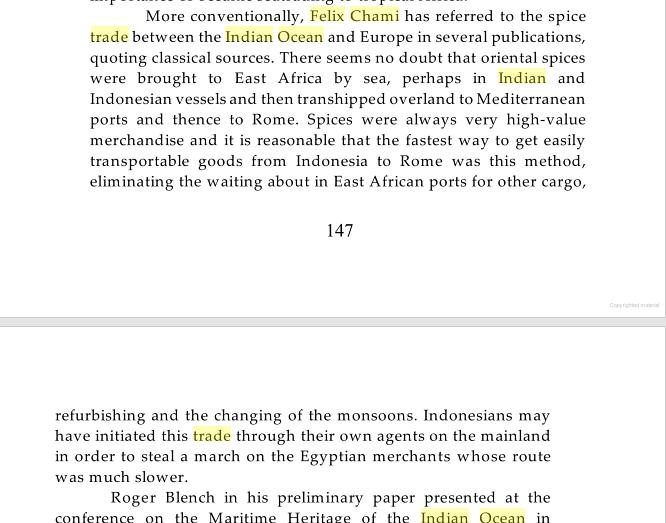Tenth-Century Arabs in Mozambique December 28, 2010
Author: Beach Combing | in : Medieval , trackback
The extraordinary reach of Islamic traders in the Middle Ages is well known. With their heartlands at the juncture of Euro-Asia and Africa – rather than stuckout on a periphery like Christian Europe – they managed to send their boats to every point of the compass. So medieval Arab traders set up bases in Canton on the Chinese coast, they made their way into Indonesia, they passed down to Nigeria in the west of Africa and past Somalia in the east. Beachcombing has always been fascinated by these journeys to the edge of the known world and recently ran across a reference that may represent one of the southern extremes of Islamic adventuring.
We know from various sources that the Arabs visited a land that they called Waqwaq on the eastern coast of Africa. The problem is that no one is quite sure where Waqwaq was – to make matters still more confusing there was also an Asian Waqwaq (another day, another post).
Southern Madagascar is often suggested, which would, of course, have taken the markab almost as far as the Cape.
A more certain reference to southern galivanting comes in Buzurg and relates to a voyage that brought Arab merchants to Sufalah, modern Mozambique, in 923.
A seaman called Isma‘ilawayh left ‘Uman [Oman] for Qanbalu [northern Madagascar] in that year, but a tempest drove his ship on to Sufalah. This aroused fear in him and his crew, for the natives were cannibals. They were taken ashore, however, and made to stay and trade for several months. Finally they were allowed to return to their ship, and the king of those parts with seven companions accompanied them on a boat and went aboard.
What follows is Isma‘ilawayh’s own description and gives a fair idea of the terrifying acumen of merchants, Islamic or otherwise:
When they were on the ship, I said to myself, ‘This king would be worth thirty dinars in ‘Uman in the market-place, and the seven [companions] 160 dinars and they have clothes worth 20 dinars; so that they would bring us at least 3000 dirhams, without any risk attached.’ I cried then to the sailors, and they raised the sails and lifted the anchors.’
The king, who tried and failed to escape, found himself a prisoner and was later sold in the slave markets of Oman. Curiously, he was then brought back to his kingdom, that he proceeded to convert to Islam.
From Mozambique to the Middle East and back again carrying monotheism on your shoulders on the return voyage: not bad for the tenth century!
Beachcombing is interested in any other references to far-sailing Arabs in the Middle Ages: drbeachcombing AT yahoo DOT com
31 Jan 2015: Bruce T writes ‘Arab, Persian and Somali sailors traded along the East African coast from early in antiquity. Indians came as far as Somalia in this period, but they’re isn’t much evidence they went further down the coast until later. The Egyptians went to Punt for two reasons, local products such as frankincense and myrrh, but also for spices from India and the Malay archipelago such as cinnamon,cardamom, and cloves. Much of the latter products were brought directly across the Indian Ocean by Malay seaman using double hulled outriggers the Romans later described as “rafts”. The Malays seem to have preceded the Arabs and Persians in Southeast Africa by quite some time. Arab chroniclers spoke of a resurgence of a Malay presence in the 10th Century when a fleet of “1000 ships from Waqwaq” showed up at Pemba in 945 C.E. to reestablish old trading ties on the East African coast. The Arabs commented that people of that part of East Africa and the Malays were fluent in each others languages. To many scholars this speaks of a long history of trading and contact. I tend to agree. According to Roman, Greek, and Arab sources the Malays had a distinct trading route. They would stop at Madagascar to resupply and gather tortoise shells. They would then head to the Mozambique coast to trade metals and tortoise shells for slaves, hides and gold. They would go up the coast to Kenya and Somalia, on the periphery of the Western world, trading spices and tortoise shells for gold, incense and western goods. The nexus of this trade was a city the Romans called Rhapta. Where Rhapta was is a crapshoot. It’s been speculated that it was it somewhere from the Horn of Africa to the area of Zanzibar, with the Horn of Africa being the current favorite.Wherever Rhapta was, it drew traders and goods from across the ancient world by the 1st Century B.C.E. A century or so later this trade came to include silk, giving it the modern name of the “Maritime Silk Road”. The Malay’s would then wait for the monsoon in the region of Somalia and head back to Sumatra, stopping at Indian and Sri Lankan ports to trade African goods for Indian products coveted in the quickly Indianizing Malay states. Waqwaq seems to have first been used for either Sumatra or Java by South Arabian and Persian sailors. When the Malay’s colonized Madagascar in the mid 1st millennium C.E. the location of Waqwaq seems to shift to Madagascar and Sumatra becomes “Zabag”. As the Malays were referred to as “The Men of Waqwaq” by the Arabs and Persians in East Africa, and they were now established in Madagascar, it would seem logical that they considered Madagascar to be part of the land of the Waqwaq, thus the transference of the name to that island, but that is strictly my opinion. I ran across a very interesting reference from a scholar in the U.A.E. speaking of medieval Arab sailing directions about how to get back around what is now called the the Cape of Good Hope.If Arab navigators happened to be swept around the Cape by storms when going down east coast of Africa after becoming caught in the strong southward Mozambique Current these directions, or ruttier, would bring them home. (Niccolo de Conti is said to have told the mapmaker Fra Mauro of just such an incident happening to an Indian ship in 1420 while de Conti was traveling in East Africa. Mauro considered it so reliable he put the tale on his 1459 Mappamundi, along with it’s Arab name, the Cape of Diab. Some claim the “reliable witness” on the Indian ship was de Conti himself.) If you’re familiar with the linguist Roger Blench, he’s done a lot of work on Austronesian – East African contacts and cultural exchanges. His stuff is always worth checking out. Note that Arab sailors, they seemed to have pioneered the “outside route” to China when the Sunda and Malacca Straights were becoming controlled by powerful local states in the 6th and 7th centuries C.E. As the kingdoms on Java were primarily concentrated on it’s north coast, Arab sailors would go along the south side of Java and turn north to the east of the island. They would go north along the eastern edge of the South China Sea until they got to Luzon, then turn west for Canton. This became known as the “outside route”. The “inside route” was much older, but faster. It began in the region of what now is Singapore and went up the west side of the South China Sea to Canton, a three week trip with the summer monsoon. In the winter the Chinese made the same trip down the inside route, while the Arabs traveled their outside route on the same winds. At roughly 10 degrees south of the equator, south of the monsoonal belt in the Indian Ocean there is a strong current that heads for the southwest with a following wind. The sailors around Java and Sumatra were well aware of it long before the common era, it was the basis of their African trade. I’ve always wondered if the Arabs didn’t learn of this route from them as it’s one of the few ways to reach Madagascar easily? It’s a two month, nearly straight shot from the Sunda Strait to the East African coast using the winter monsoon to give you a push to the southwesterly current and favorable following winds. It lets you dodge the locals and Persian and Indian pirates on the high seas. It makes me wonder at times if it wasn’t Arab sailors who nabbed (or traded) for those Barito women on their way home from China, (Borneo was on the outside route), and foundered off the southern coast of Madagascar?’ Thanks Bruce!
24 Feb 2015: Bruce T write again about one Felix Chami who has enthusiastically shown how Easter Africa was part of Indian Ocean trade in the the first millennium of our era. Include here a very brief summary from Montgomery A Beautiful Ivory Bangle and this BBC link.




